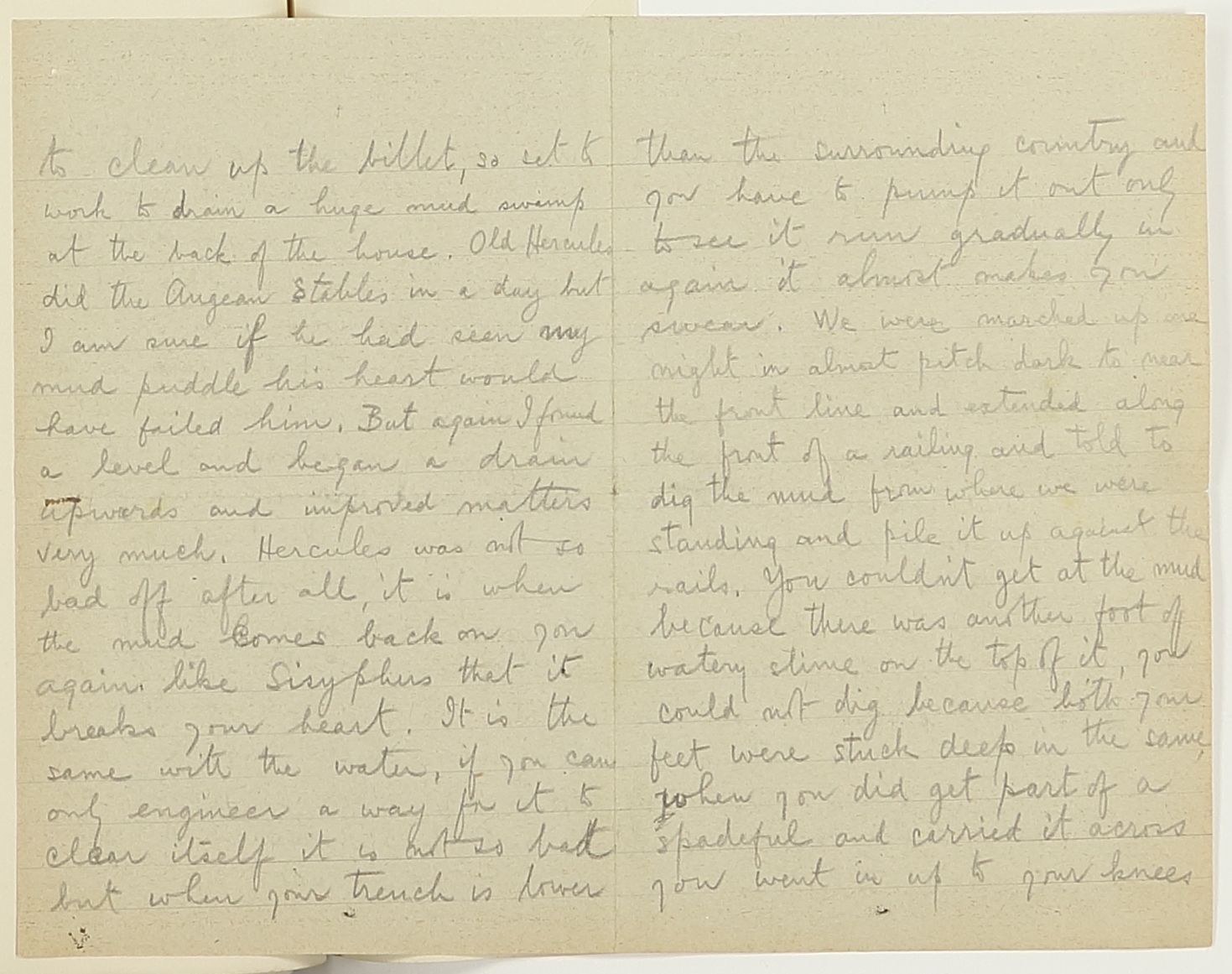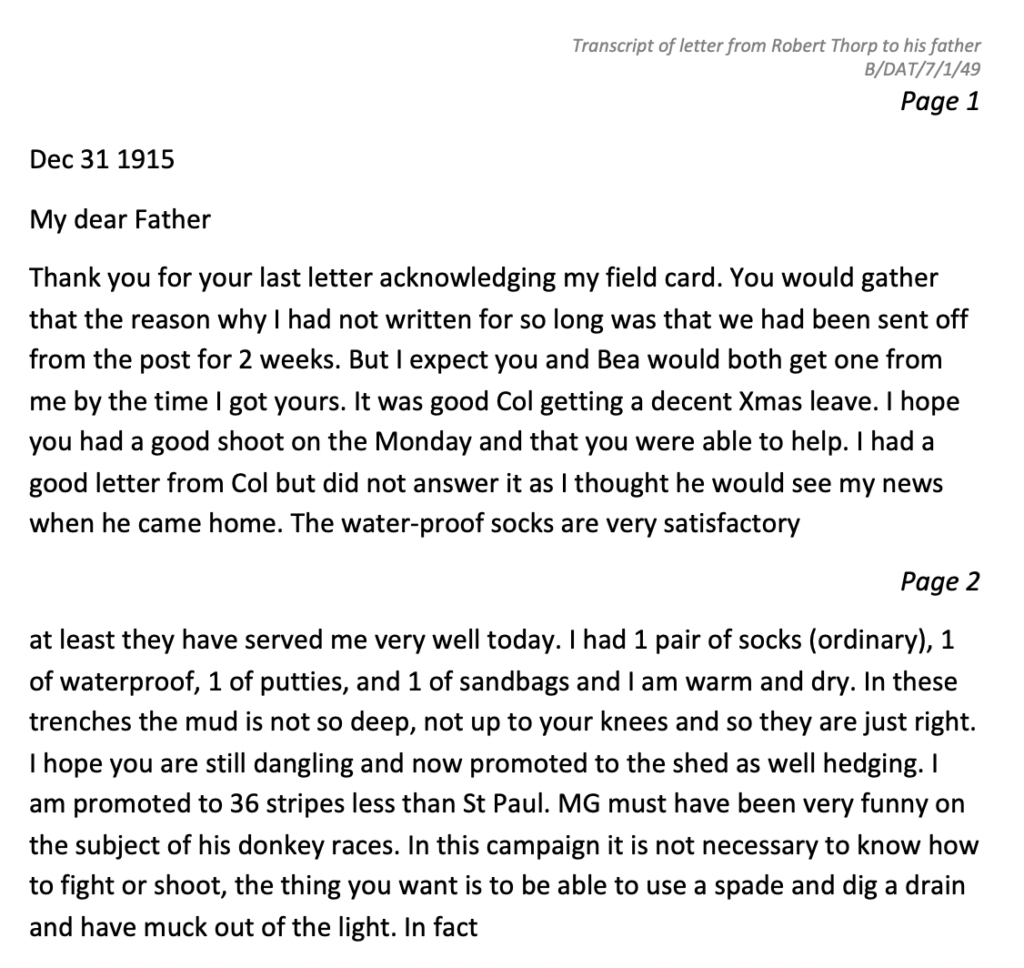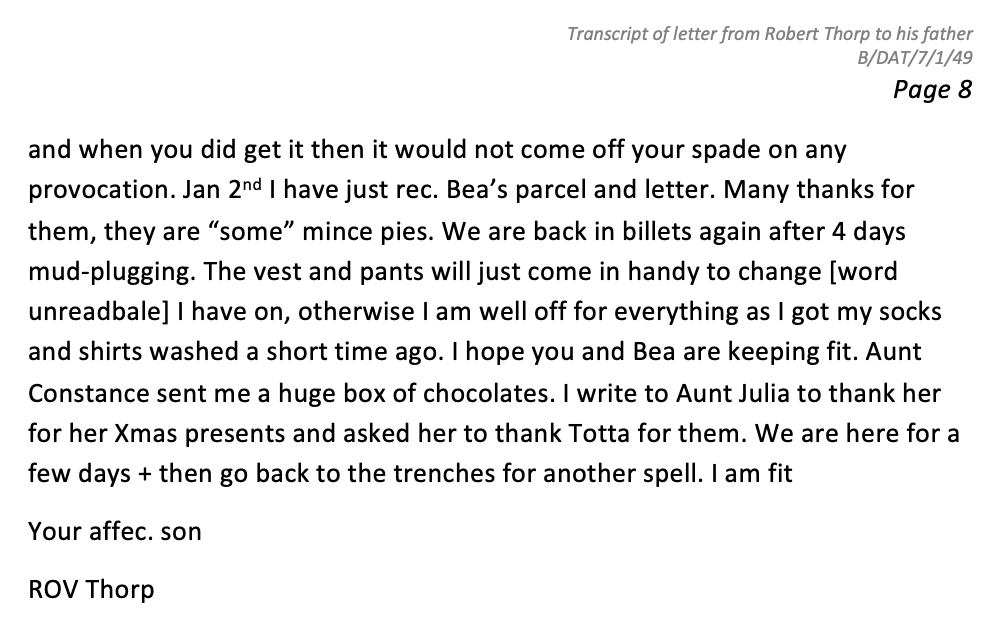Letter from Robert Oakley Vavasour Thorp to his father, 31 December 1915
Reference: B/DAT/7/1/49
Suggested age groups: KS3, KS4, Lifelong Learners
Subject areas: History, Literacy, Music
CONTEXT
Robert Thorp was the son of Reverend William Tudor Thorp, the vicar of Ellingham. Robert went to Berwick Grammar School. He worked as a teacher in Manchester. This is one of the letters that Robert sent to his father while he was serving in the army during the First World War.
Robert was awarded the Military Cross (a medal for bravery) in 1916. He was killed in France on 22 March 1918.
At the beginning of his letter Robert mentions a “field card” that he sent to his family. This was a pre-printed postcard that was given to soldiers by the army (see Imperial War Museum link). Soldiers would delete sections on the postcard in order to send a quick message back home. Field postcards were also much easier for the army, because they didn’t need an officer to read and censor them.
Robert mentions other members of his family in the letter to his father. He writes about Col, his brother, Collingwood. Collingwood was also in the army, but did not go to France until 1916 (so in 1915 he could get home for Christmas). Robert also mentions Bea, their sister, both Robert and Collingwood wrote to Bea regularly throughout the war. At the end of the letter he mentions Aunt Constance, Aunt Julia and “Totta” who had all sent him Christmas presents, including mince pies and a big box of chocolates.
At the end of the first page of his letter, Robert talks about the waterproof socks that his family sent to him and describes what he is wearing on his feet in the trenches:
The waterproof socks are very satisfactory at least they have served me very well today. I had 1 pair of socks (ordinary), 1 of waterproof, 1 of putties, and 1 of sandbags and I am warm and dry. In these trenches the mud is not so deep, not up to your knees and so they are just right.
Putties (or puttees) were strips of cloth that soldiers wound around their lower legs. British soldiers in India before the war saw Indians wearing puttees and started using them as cheap and comfortable calf protectors. They were used widely by British and Commonwealth soldiers during the First World War.
Sandbags were essential in the construction of the trenches (see Photographs of Northumberland Fusiliers in the trenches, 1915). Soldiers used the material sack from the sandbags for all sorts of things, including trying to keep warm and dry.
Trenches – system of trenches dug into the ground. Not all of the trenches were directly “at the front”. (See Long Long Trail webpage for diagram.)
Billets – soldiers were not in the trenches all of the time. They usually spent a few weeks in the trenches and then a few weeks in “billets”. Billets were building away from the front, often abandoned farm buildings.
Robert writes about the conditions that he lives in and about the work involved in keeping the billets and trenches useable. Pages 3 and 4, in particular, provide a good description of a trench and the efforts needed to maintain it.
In fact it is not a fight against the enemy but against the opposing circumstances of mud, water and the law of gravity. We have been out nearly 2 months and I have not fired a shot but every single day since we landed I have been busy contending against dirt and discomfort. (Page 3)
Writing and receiving letters was extremely important to the soldiers serving abroad during the First World War. Over 12 million letters and parcels were delivered to the trenches each week (see links below for more about the wartime postal service). As well as letters, soldiers received parcels of food and clothing.
ACTIVITIES
ACTIVITY 1
Background
Robert Thorp was the son of Reverend William Tudor Thorp, the vicar of Ellingham. This is one of the letters that Robert sent to his father while he was serving in the army during the First World War.
Writing and receiving letters was extremely important to the soldiers serving abroad during the First World War. Field postcards were also much easier for the army, because they didn’t need an officer to read and censor them.
SEE
See: Who is Robert writing to?
See: Which family members does Robert mention in his letter?
See: How does Robert describe the conditions in the trenches?
See: What does Robert describe fighting against?
See: What contact does Robert describe having with the German soldiers?
THINK
Think: What impression does Robert give you of the trenches?
Think: How does Robert’s mood seem?
Think: Do you think this is a typical representation of letters that soldiers wrote home from the trenches?
Think: Do you think Robert gave an accurate representation of being in the trenches, or do you think he over- or under- exaggerated? Why?
Think: Did anything surprise you about the letter?
Think: Why was letter writing so important during WW1?
Think: Why were letters censored by an officer?
DO
Do: Write down a list of the words in Robert’s letter that are new or unfamiliar to you.
Do: Find the definitions of these new or unfamiliar words.
Do: Make illustrated definitions for these words so that someone else reading Robert’s letter can use your definitions to understand the letter.
Do: Create a piece of descriptive writing about what it was like for soldiers living in trenches inspired by Robert’s description of the trenches.
Do: Imagine you are a soldier serving in WW1. Write a letter home to your family to update them as Robert did.
Do: Swap letters with someone else. Go through their letter and censor any information that you think an officer would have censored.
Do: Write a poem inspired by WW1 letter writing. You could create a piece of music for this poem to be set, to inspired by Carol Ann Duffy’s performance at Durham Cathedral.
Resources
OTHER ONLINE RESOURCES
Robert Thorp
Commonwealth War Graves Commission website, page about Robert Thorp: https://www.cwgc.org/find-records/find-war-dead/casualty-details/315901/R%20O%20V%20THORP/
The London Gazette website, page for medals awarded 24 November 1916 (look for Robert Thorp at the bottom of the page): https://www.thegazette.co.uk/London/issue/29837/supplement/11545
North East War Memorials Project website, page for Berwick Grammar School war memorial: http://www.newmp.org.uk/detail.php?contentId=6563
North East War Memorials Project website, page for Ellingham Church plaque: http://www.newmp.org.uk/detail.php?contentId=7098
Postal Service During First World War
BBC website, page about postal service during the First World War: https://www.bbc.co.uk/news/magazine-25934407#:~:text=During%20World%20War%20One%20up,former%20Home%20Secretary%20Alan%20Johnson.
Postal Museum website, pdf of learning resources about the postal service and communications during the First World War: https://www.postalmuseum.org/wp-content/uploads/2017/01/Last-Post-full-learning-resource.pdf
Imperial War Museum website, page showing field postcard: https://www.iwm.org.uk/collections/item/object/205131476
Letter Writing: Durham Hymns
Durham Hymns was part of the 100 year commemorations of the First World War.
Carol Ann Duffy used archives, including
letters, from Durham Record Office to write poems that were set to
music and performed at Durham Cathedral.
Durham at War website, page about Joseph Furness (including a transcript of this last letter to his wife: https://www.durhamatwar.org.uk/story/12683/
Vimeo website, video of “Kiss the Bairns for Me” performance, at Durham Cathedral: https://vimeo.com/243147618
Life in the Trenches
The Long Long Trail website, page for life in the trenches: https://www.longlongtrail.co.uk/soldiers/a-soldiers-life-1914-1918/life-in-the-trenches-of-the-first-world-war/
Youtube website, page for tour of a trench reconstruction with Andy Robertshaw: https://www.youtube.com/watch?v=lgRm7aU-GoI
Youtube website, aerial photography of a trench reconstruction: https://www.youtube.com/watch?v=hAJfRrkq_nk
Imperial War Museum website, page for oral history podcast about like in the trenches: https://www.iwm.org.uk/history/voices-of-the-first-world-war-trench-life










